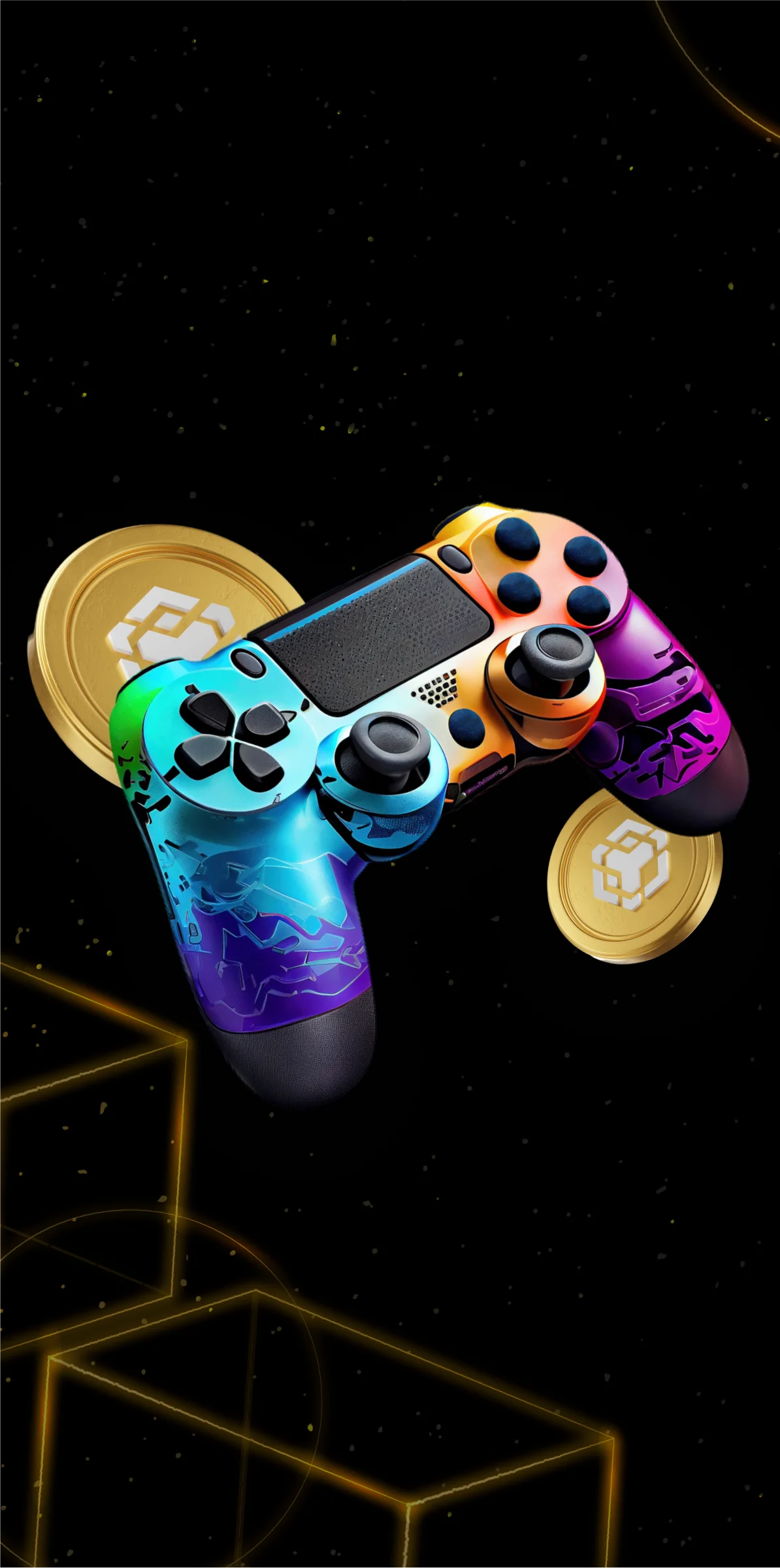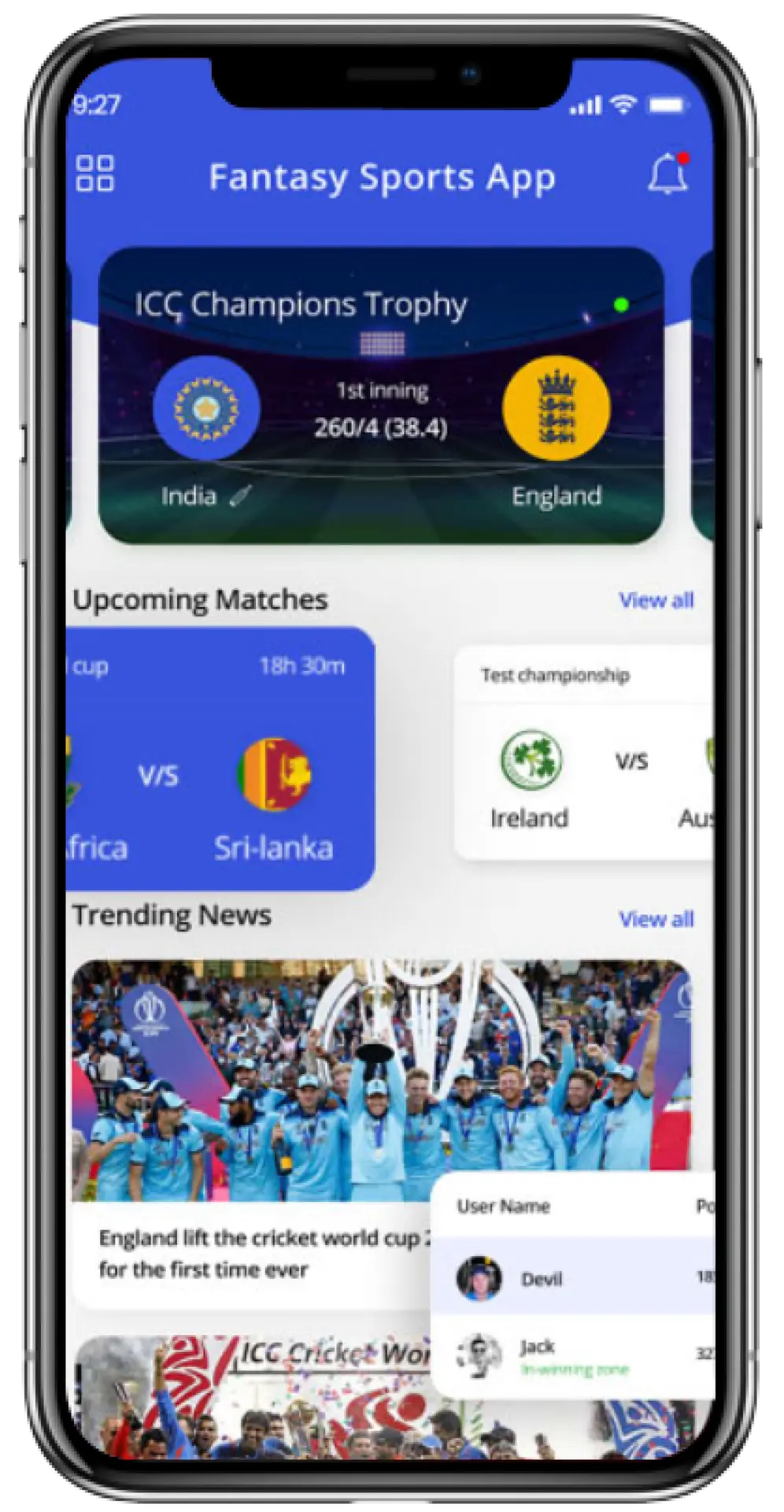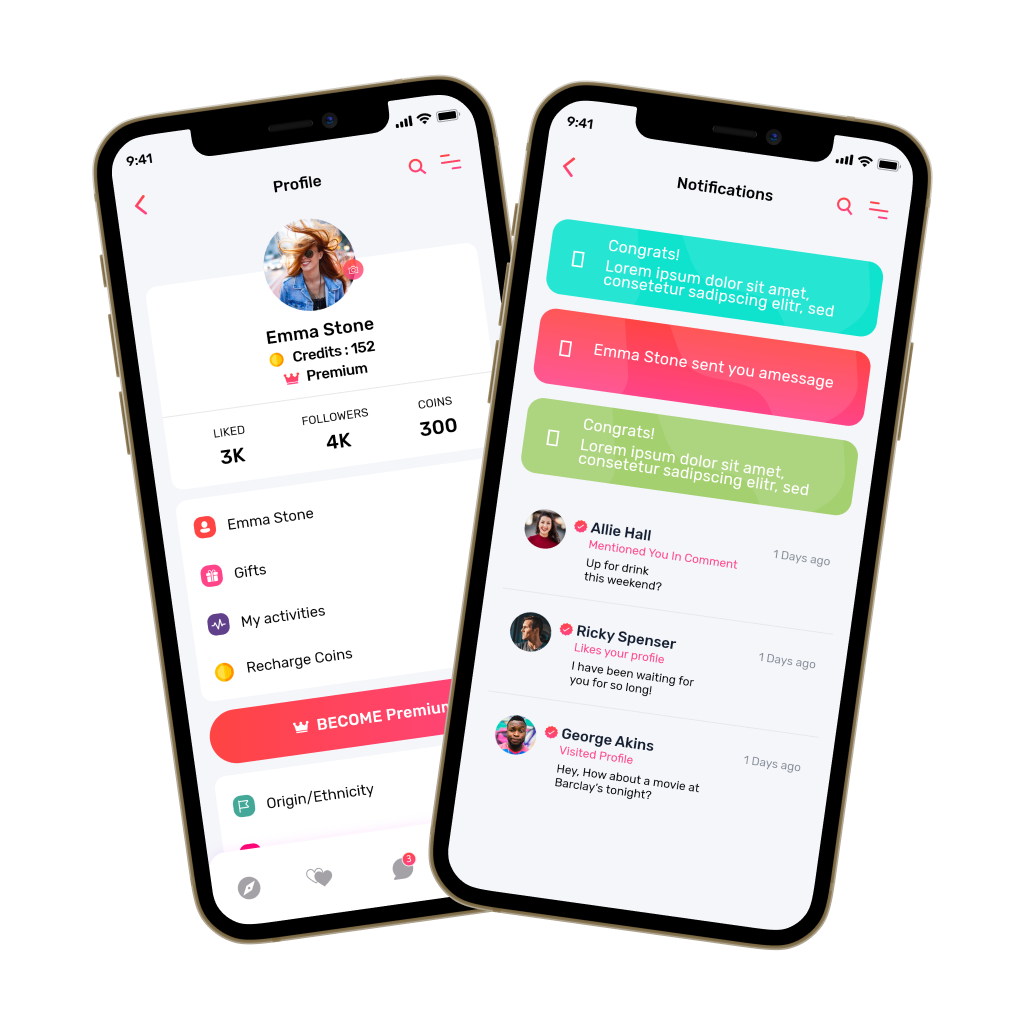Math is one of those subjects where a bit of confidence can completely change how a child approaches learning. Many students struggle with multiplication, and that struggle often affects their performance in other areas of math. Parents and teachers see every day that worksheets may work for some learners, but they rarely hold attention for long. A times tables app like TTRockStars can genuinely improve this experience because it turns practice into something interactive and rewarding.
These platforms often use quick-fire challenges and character-based progression that make the process feel more like a game than a lesson. Adaptive difficulty and real-time scoring can help students learn at a pace that actually fits their skill level.
Over the years, we’ve worked on a lot of gamification-driven learning solutions that use technologies like ML-based skill modeling and real-time gamification frameworks. Leveraging our deep technical know-how, we’re writing this blog to discuss the steps to develop a times tables app like TTRockStars. Let’s start!
Key Market Takeaways for Times Tables App for Kids
According to MarketUs, the mobile EdTech market is projected to grow from USD 7.5 billion in 2024 to nearly USD 84 billion by 2034, a leap that shows just how quickly digital learning has become part of children’s everyday lives. Families and schools are increasingly turning to mobile tools that feel natural for kids to use, and North America continues to lead this shift with strong adoption and steady investment in educational apps.
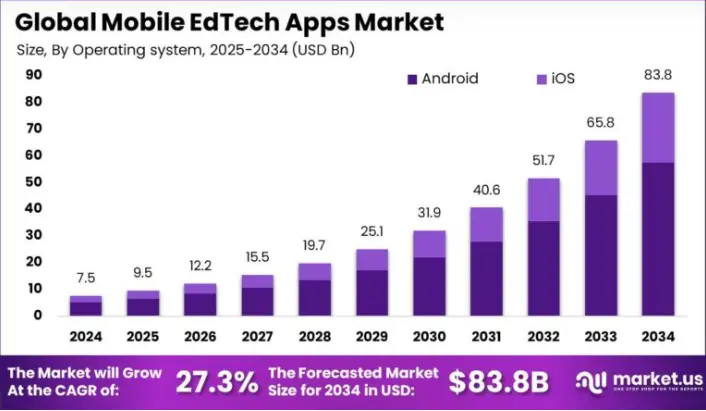
Source: MarketUs
Much of this momentum comes from tools that help children build essential skills in a way that feels engaging rather than repetitive. Times tables apps, in particular, have gained traction because they turn a traditionally tedious task into something more dynamic. Through games, challenges, and clear progress tracking, these apps give children a sense of accomplishment while helping parents and teachers understand how well the core skills are developing.
Times Tables Rock Stars and DoodleTables show how effective this approach can be. Times Tables Rock Stars adds excitement through competitive modes and customization that motivates kids to improve their accuracy and speed.
DoodleTables focuses on a more tailored learning path, offering practice that adapts to each child’s strengths and weaknesses. Together, they demonstrate how digital tools can make foundational math skills feel more accessible, enjoyable, and meaningful for young learners.

What is the TTRockStars App?
The TTRockStars app is a maths learning platform that helps children build confidence and speed with their times tables. It is designed for ages six and up and turns multiplication and division practice into short, game-based sessions that children can play on a phone, tablet, or web browser.
Each activity adapts to the child’s performance, so learners receive questions that match their current level and help them progress at the right pace.
Here are some of its standout features,
Gamified Learning
Children earn virtual coins for correct answers and use them to customise their rock star avatar. As their speed improves, they advance through ranks such as “New Artist” and eventually “Rock Hero,” which gives them clear goals and a sense of achievement.
Multiple Game Modes
The app includes a mix of solo games and real-time multiplayer battles. Single-player modes allow children to practise at their own speed, while competitive modes let them play against classmates or other users, creating a fun and social learning experience.
Adaptive Questioning
TTRockStars automatically adjusts to each learner. If a child struggles with certain facts, those questions appear more often until the learner becomes confident in that area. This keeps practice challenging but manageable.
Accessible and Inclusive Design
The app supports a range of learning needs through features such as alternative colour schemes, adjustable text size, dyslexia-friendly fonts, decluttered screens, hidden timers, and audio-read questions. These options help reduce pressure and make the app more accessible.
Progress Tracking
Children can view their own statistics and improvements over time, while parents and teachers receive detailed reports on speed, accuracy, and progress. Leaderboards and printable certificates offer additional motivation.
Safe and Child-Friendly Environment
The app includes no advertisements, no in-game purchases, and no chat features. Rock names keep user identities private, and the platform follows strong data-protection standards, making it safe for children.
Quick and Easy Access
Games can be launched with a single tap, and the app works across all common devices. This makes it easy for children to fit short practice sessions into their day, whether at home, in school, or on the go.
How Does the TTRockStars App Work?
The TTRockStars app works by running an adaptive engine that monitors response speed for each fact and adjusts question difficulty in real time so practice stays efficient. t uses a structured data model that can flag weak facts instantly and might guide learners toward stronger fluency through targeted repetition.
As play continues, the system triggers timed modules that measure performance precisely and drive recall speed toward an automatic level.
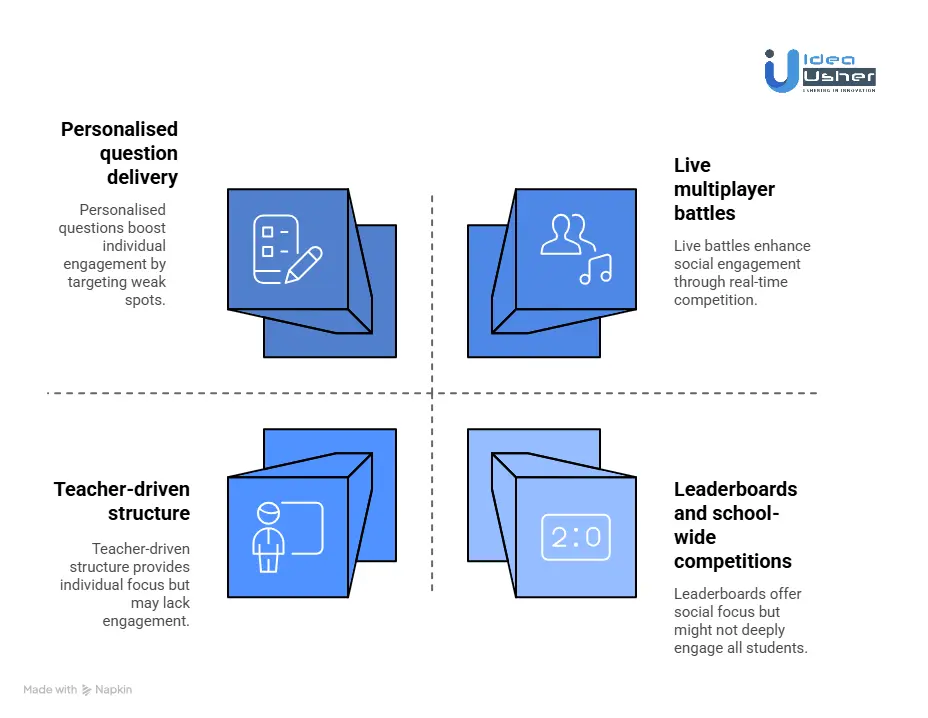
1. The Core Mission
Traditional times tables practice often stops at accuracy. TTRockStars goes further.
Its main goal is automatic recall, meaning a learner can answer any multiplication fact up to 12×12 almost instantly. TTRS defines this as answering within three seconds.
This focus on speed matters. When multiplication facts are automatic, they move into long-term memory. That frees up mental space for more advanced maths, reducing cognitive load during problem-solving.
2. The Adaptive Learning Engine
The “Garage” mode is where most of the adaptive learning happens.
- Personalised question delivery: The system monitors every answer a child gives, tracking both accuracy and response time. It then adjusts the next set of questions based on this performance.
- Targeting weak spots: If a learner hesitates or repeatedly gets a fact wrong, such as 7 × 8, the system flags it as a “wobbly fact.” These facts appear more often in future sessions until they become secure. This works much like spaced-repetition techniques used in modern learning tools.
- Teacher-driven structure: Teachers can select which times tables are in focus each week. This makes the Garage a direct extension of classroom learning rather than a separate or random practice tool.
3. The Gamification Layer
The rock star theme is not just a visual style. It fuels the reward system that keeps children practising.
Avatars and “Rock Coins”
Children create their own rock star character. Every correct answer earns coins, with speed boosting the reward. These coins buy outfits, instruments, and accessories, giving learners a reason to practise regularly.
Status progression
Instead of simple levels, students rise through rock statuses such as “Wannabe,” “Breakthrough Artist,” and eventually “Rock Legend.” Status is tied to average answer speed, so improvement is visible and meaningful.
The Rock Shop
This is where students spend their coins. Because upgrades require consistent earnings, it reinforces regular practice.
4. Social and Competitive Play
TTRockStars turns maths into a shared experience rather than a solo task.
- Live multiplayer battles: Modes like “Rock Slam” let students challenge classmates in real time. This creates a sense of excitement similar to a game show or sports match.
- Leaderboards and school-wide competitions: Students can see how they compare to their class, their school, or other participating schools. Events like “England Rocks” or class-run “Rock Wrangles” build community and friendly rivalry.
- The Festival: This mode matches players with random opponents worldwide, giving children a wider arena to test their skills.
5. The Teacher Dashboard
A major strength of TTRS is the robust set of tools available to educators.
- Practice management: Teachers can assign specific tables, set weekly focuses, or control which modes are available.
- Data and analytics: Each student’s performance is displayed through heatmaps and detailed reports that highlight fluent facts (green), slow facts (yellow), and problem areas (red). This helps teachers plan intervention and support with precision.
- Classroom administration: Teachers can manage accounts, reset passwords, and organise students into groups or “bands” for class competitions.
What is the Business Model of the TTRockStars App?
TTRockStars operates on a Software as a Service model, providing subscription-based access to its digital learning environment. The platform is designed for use in both classrooms and homes, serving a wide audience that includes:
- Schools and multi-academy trusts purchasing multi-user licenses
- Families subscribing for at-home learning
- Tutors and small learning groups using the platform for personalised practice
The company’s revenue comes primarily from these subscription streams. There are no advertisements, in-app purchases, or chat functions, which makes the environment safe and focused on learning.
School Subscriptions
Schools purchase annual licenses that provide full access to learning modes, progress dashboards, reporting tools, and multi-user functionality.
Family Subscriptions
Parents can subscribe to individual or family plans. These plans allow children to practise their times tables at home with the same personalised learning experience available in schools.
Tutor Licences
Tutors can purchase smaller-scale subscription packages that are ideal for one-to-one or small-group sessions.
Financial Performance and Growth
While the company does not publicly disclose detailed revenue figures, TTRockStars has achieved strong, consistent growth. Key highlights include:
- More than 75 percent of export revenue growth within a three-year period
- Expansion from the UK and Ireland to more than 20 countries
- A rapidly increasing user base, with millions of children using the platform weekly
This growth reflects the platform’s effectiveness and strong demand across different educational markets.
Funding and Company Evolution
TTRockStars was founded by former teacher Bruno Reddy, who first created the concept as a paper-based classroom resource. Between 2013 and 2016, it evolved into a scalable SaaS product. The company grew through bootstrapping and reinvestment rather than external venture funding, which allowed it to maintain full control over its direction and mission to improve numeracy education globally.
How to Develop a Times Tables App Like TTRockStars?
To build a times tables app like TTRockStars, you would create a strong curriculum engine that adapts to each learner and updates difficulty in real time. You then set up a backend that can handle rapid gameplay events and deliver multiplayer features with high stability. We have developed many edtech apps like this for our clients over the years and we can confidently show how we do it.

1. Curriculum and Learning Logic
We begin by mapping out the complete set of multiplication facts and organizing them into a progressive learning sequence. Our team defines fluency targets for each stage and ensures the curriculum aligns with regional education standards. This gives the entire platform a solid pedagogical foundation and makes it classroom-ready from day one.
2. Adaptive Engine & Spaced Repetition Model
Next, we create an adaptive learning engine that evaluates user performance and adjusts question difficulty automatically. We build targeted logic to highlight each student’s wobbly facts and reinforce them through spaced repetition. Our mastery algorithms ensure learners advance only when they are truly ready, which leads to measurable improvement.
3. Gamification & Identity System
We then craft an engaging gamification layer that keeps students motivated. This includes designing avatars, building the coin and reward loops, and developing badge-based progression. Every element is intentionally tied to the learning journey, so students stay excited while still focused on mastering multiplication.
4. Multiplayer & Leaderboards
For clients who want competitive features, we develop real-time multiplayer systems that are fast, fair, and scalable. Our team builds matchmaking logic, live score tables, and event-based tournament modes that create a dynamic and engaging experience for students. All components are optimized to run smoothly even under heavy school traffic.
5. Teacher, Parent & Admin Dashboards
We also design powerful dashboards that give teachers, parents, and administrators clear visibility into student progress. These dashboards include performance reports, assignment tools, and classroom management capabilities. This ensures the app is not only fun for students but also genuinely useful for educators.
6. Test and Scale for Classroom Use
Before launch, we run pilot programs with real classrooms to validate engagement and identify friction points. Our team performs load testing to confirm the system can handle peak school-hour activity. We refine the UX based on feedback from young learners and educators, ensuring the final product is polished, reliable, and ready for wide adoption.

How Much Revenue Can a Gamified Times Tables App Generate?
The Ed-Tech market represents one of the most dynamic and financially promising sectors today. A gamified times tables app, when executed correctly, is not just an educational tool but a highly scalable and profitable business. By analyzing the business models of leading apps like TTRockStars, DoodleTables, and others, we can construct a realistic revenue model.
Let’s break down the potential revenue streams and provide a conservative estimate for a successful app in this space.
The Business Model: A Powerful B2B2C Engine
The most successful apps in this category utilize a B2B2C (Business-to-Business-to-Consumer) model, which creates multiple, reinforcing revenue streams:
- B2B: School & District Licenses: The primary driver of stable, recurring revenue.
- B2C: Parent & Home Subscriptions: A high-margin upsell channel driven by school adoption.
- In-App Purchases: An engagement-driven revenue stream for cosmetic enhancements.
Estimated Revenue Calculation
Let’s model a hypothetical app that has achieved strong market penetration over 3-4 years, focusing on the UK and US markets.
Base Assumptions:
- School Pricing: Based on industry standards, an average of $12.50 per student per year for a site license.
- Parent Pricing: A home subscription is typically priced at around $100 per child per year.
- Scale: The app is used in 500 schools, with an average of 300 primary-aged students per school.
Revenue Stream 1: School Subscriptions
This is the most critical and stable revenue stream, often forming the foundation of the business.
- Total Addressable Students: 500 schools * 300 students = 150,000 students
- Calculation: 150,000 students * $12.50/year = $1,875,000 Annual Revenue
Justification: TTRockStars is used in over 15,000 schools globally. Even a fraction of this market share represents a multi-million dollar business. School budgets for proven literacy and numeracy tools are robust and recurring.*
Revenue Stream 2: Parent/Home Subscriptions
When a child uses the app in school and enjoys it, parents are highly likely to subscribe to continue learning at home, especially during holidays.
- Conversion Rate: A conservative conversion rate of 12.5% of the school user base is achievable for a high-engagement app.
- Paying Families: 150,000 students * 12.5% = 18,750 families
- Calculation: 18,750 families * $100/year = $1,875,000 Annual Revenue
Justification: Companies like DoodleLearning have reported over 100,000 family subscriptions. This channel leverages the school’s endorsement, drastically reducing customer acquisition costs.
Revenue Stream 3: In-App Purchases
This stream involves selling virtual currency (e.g., coins, gems) for cosmetic items such as avatar customization, accessories, and pets. These purchases must be cosmetic-only to maintain educational integrity.
- User Base: 150,000 (school) + 18,750 (home) = ~168,750 highly engaged users
- Average Revenue Per Paying User (ARPPU): A conservative estimate, assuming a small percentage of users make occasional purchases, leading to an effective ARPPU of $3.55 per year across the entire user base.
- Calculation: 168,750 users * $3.55/year = ~$600,000 Annual Revenue
While not as dominant as subscriptions, IAPs provide a significant revenue boost and increase user engagement and retention, as seen in many successful gamified platforms.
Consolidated Annual Revenue Estimate
| Revenue Stream | Calculation | Annual Revenue |
| 1. School Subscriptions | 150,000 students @ $12.50/yr | $1,875,000 |
| 2. Parent/Home Subscriptions | 18,750 families @ $100/yr | $1,875,000 |
| 3. In-App Purchases | 168,750 users @ $3.55/yr | $600,000 |
| Total Estimated Annual Revenue | $4,350,000 |
This model demonstrates a realistic potential to generate over $4 million in Annual Recurring Revenue (ARR) for a successfully established app.
Context and Validation from the Market
- TTRockStars: Its presence in thousands of schools worldwide suggests a revenue stream comfortably in the tens of millions of dollars. The school-centric model provides immense financial stability.
- DoodleLearning: With reported usage in 2,500+ schools and 100,000+ families, a back-of-the-envelope calculation using our pricing model would place their potential revenue in the $15-20 million range, validating the scale of our estimates.
- Reading Eggs/Eggy Times Tables: With a vast user base of over 20 million, this demonstrates the massive consumer demand that exists, justifying the potential of the B2C subscription model.
Why Children Learn 3x Faster With Gamified Math Learning Apps?
According to research on educational games, children learn significantly faster when math practice is delivered through short, engaging game-based sessions. One study found that with only two 15-minute sessions per week, students using math games advanced up to 3 times faster than those using traditional methods.
The combination of quick feedback, built-in motivation, and low-pressure challenges helps kids stay focused and make rapid progress.
1. Dopamine Drives Motivation
Traditional math practice often relies on pressure, such as tests, grades, or adult reminders. Gamified learning changes that dynamic.
How it works: When kids solve a problem, earn a star, unlock a level, or collect a reward, their brain releases a small burst of dopamine. This neurotransmitter fuels motivation and reinforces behavior.
Why it matters: The brain begins to connect math with achievement and enjoyment. Practice becomes voluntary, and kids return to the app because they like the feeling of progress.
2. Games Trigger a Flow State
Psychologist Mihaly Csikszentmihalyi described flow as the state of deep focus where people lose track of time and perform at their best.
How it works: Good games constantly adjust their difficulty. If a task is too easy, kids disengage. If it is too difficult, they shut down. Adaptive apps stay in the middle by keeping tasks challenging enough to be interesting but never overwhelming.
Why it matters: In a flow state, attention sharpens and distractions fade. A short, focused session in this mental zone can produce more learning than a much longer period of unfocused homework.
3. Micro Learning With Instant Feedback
Kids learn best when information comes in small doses and feedback arrives right away.
How it works: Instead of long worksheets, games present short rounds, problems, or missions. Each answer is followed by immediate feedback. Correct answers are reinforced instantly, and mistakes lead to another quick attempt.
Why it matters: This rapid feedback loop helps kids correct misunderstandings immediately and strengthens accurate knowledge before it fades from memory.
4. Games Lower Anxiety
Math anxiety is a real issue, and it reduces the working memory children need to process new information.
How it works: Games treat mistakes as part of the experience. A wrong answer is not a failing grade. It is simply another try. There is no red pen, no embarrassment, and no pressure from peers.
Why it matters: When the emotional weight is removed, kids take more risks, attempt harder problems, and stay engaged for longer periods of time. Their mental energy can focus on solving problems rather than managing stress.
Common Challenges to Develop a Times Tables App
Building a multiplication practice app with the engagement level of TTRockStars is an exciting project, but it also comes with very real technical, UX, and scalability challenges.
After creating similar platforms for multiple clients, our team at Idea Usher knows exactly where teams usually struggle and how to solve those issues before they become costly problems.
1. Designing a Child-Friendly UX
Kids around seven years old need interfaces that make sense instantly. If navigation feels confusing or if buttons are too small, menus are too deep, or feedback is unclear, they will lose interest quickly. A child should be able to open the app and start learning without needing instructions.
How We Solve It:
We follow a strict “Tap and Learn” design philosophy:
- Icon-First Navigation: Universal, kid-friendly icons replace text-heavy menus.
- Bold, Consistent Visuals: High-contrast colors and large tappable targets reduce errors and hesitation.
- Simple Reward Loops: Practice, earn rewards, customize, and repeat, all within a few taps.
- Real-World Usability Tests: We test with actual kids and refine the experience until every confusing moment is eliminated.
2. Eliminating Lag in Multiplayer Battles
In fast-paced features like Rock Slams, even a split-second delay breaks the experience. Lag creates frustration, unfair gameplay, and rapid user drop-off.
How We Solve It:
- Dedicated Game Servers: Real-time gameplay runs on optimized servers instead of generic web servers.
- Persistent WebSocket Connections: These provide instant, two-way communication between players and the server.
- Lag Compensation and Prediction Models: Advanced algorithms offset minor network issues to keep battles smooth and fair.
3. Handling Massive Usage Spikes
Schools often use these apps simultaneously, especially during scheduled competitions. If hundreds or thousands of students log in at the same time, an unprepared backend will buckle.
How We Solve It:
- Auto-Scaling Infrastructure: With AWS or Google Cloud, server capacity increases on demand and shrinks during off-hours to reduce costs.
- Microservices Architecture: Core systems such as gameplay, authentication, and analytics are separated so no single bottleneck can crash the entire app.
4. Scaling Cloud Resources
A scalable system is essential, but an inefficient one leads to unpredictable cloud bills. Many apps fail because operational costs spiral out of control.
How We Solve It:
- Right-Sized Environments from Day One: Resources are provisioned based on real usage forecasts instead of assumptions.
- Strategic Use of Serverless Tools: AWS Lambda, Cloud Functions, and similar tools keep costs tied directly to actual usage.
- Real-Time Cost Monitoring: Dashboards and alerts help us catch anomalies early and optimize before costs spike.

Tools & APIs Needed for a Times Tables App Like TTRockStars
Creating an engaging and high-performance times tables app requires more than sleek visuals. It demands a thoughtful blend of development frameworks, real-time systems, analytics, and security. Here is a clear breakdown of the technologies that can power an app with the same energy and reliability that make TTRockStars a classroom favorite.
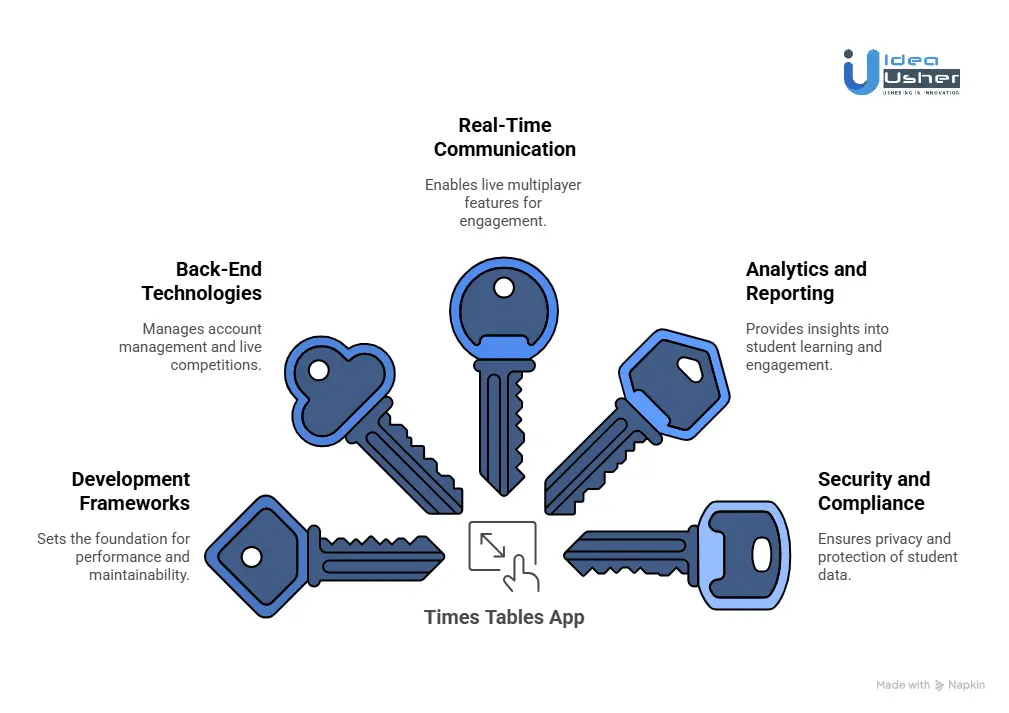
1. Development Frameworks
The development framework sets the foundation for performance, consistency, and long-term maintainability.
Flutter or React Native
A cross-platform framework is essential if you want to reach both iOS and Android users efficiently.
- Flutter uses its own rendering engine and a single codebase to deliver smooth, consistent interfaces across devices.
- React Native brings JavaScript familiarity and a huge ecosystem, allowing quick iteration and flexible integration.
Your choice depends on your team’s expertise and the type of animations and interactions you want to support.
Unity for Gamified Visuals
If you want to elevate the rock star theme with lively characters, animated effects, or mini-game elements, Unity is ideal. Even lightweight integrations can produce high-quality 2D and 3D animations that make practice sessions feel more like a performance than a worksheet.
2. Back-End Technologies
The back-end is responsible for everything behind the scenes, from account management to live competitions.
Node.js or Django
Node.js is ideal for real-time features like live competitions thanks to its fast, event-driven design, while Django offers a secure, structured Python framework that speeds up development and handles student data and adaptive learning tools with reliability.
Firebase, AWS, or Google Cloud
Firebase supports rapid development with built-in real-time databases, authentication, and analytics, while AWS and Google Cloud provide highly scalable infrastructure and powerful database services that can handle heavy traffic during school competitions and large events.
3. Real-Time Communication
Live multiplayer features are a major engagement driver in apps like TTRockStars, and they require the right technologies to keep competition fast and fair.
WebSockets
This protocol handles persistent, two-way communication between the server and the user’s device. WebSockets allow instant question delivery, answer submission, and live score updates, creating smooth and exciting real-time battles.
RabbitMQ or Kafka Message Brokers
As your user base expands, the platform needs to manage large volumes of game events, notifications, and analytics data.
- RabbitMQ is excellent for task queues and reliable message delivery.
- Kafka shines when handling high-throughput event streams.
Both prevent overload during peak activity, such as class tournaments or school competitions.
4. Analytics and Reporting
Understanding how students learn and where they struggle is key to improving outcomes and demonstrating value to educators.
Mixpanel or Google Analytics for Firebase
These tools track detailed in-app actions, such as completing a practice session or improving speed on a specific times table. They help you identify learning patterns, drop-off points, and features that drive engagement.
Custom AI-Powered Insights
A custom analytics layer gives you a significant advantage. Machine learning models can flag students who may be losing motivation, generate individualized practice plans, and reveal classroom-wide trends. This transforms data from simple metrics into actionable recommendations for teachers and parents.
5. Security and Compliance
When developing a children’s app, privacy and protection must be embedded into every layer of the system.
AWS Cognito
This service handles secure user logins, account management, and multi-device authentication. It is built to scale and helps enforce proper access controls.
Role-Based Encryption and Access Control
Data protection must apply both in storage and in transit. Using encryption and role-based access ensures that students only access their own information, teachers can view their class data, and administrators have broader control. This structure is essential for ethical data handling.
COPPA and GDPR Compliance
Compliance with child-focused privacy regulations is non-negotiable. Designing with COPPA and GDPR in mind from the start helps ensure proper parental consent flows, clear data controls, and responsible data minimization. Schools and parents immediately recognize and trust platforms that take these obligations seriously.
Conclusion
A well-designed times tables app can strengthen core numeracy through adaptive practice that reacts instantly to each learner, and it can also meet the rising demand for clear performance data in modern classrooms. Investors and education teams might see real potential here because schools now need tools that run reliably, integrate cleanly with existing systems, and scale without heavy overhead. With stable machine learning logic, efficient data flows, and a user experience built for daily classroom use, this space could offer a timely and technically viable growth path.
Looking to Develop a Times Tables App Like TTRockStars?
IdeaUsher can help you build a times tables app with a solid architecture that scales efficiently and supports real-time performance. With over 500,000 hours of coding experience, our team of ex-MAANG FAANG developers might guide you through adaptive learning logic so the engine responds intelligently to each learner.
We also integrate secure data handling with cross-platform frameworks, which could deliver a product that schools can trust.
End-to-End Development
Whether you’re starting with a sketch or a fully formed concept, we handle every part of the process:
- Gameplay mechanics and character design
- Teacher dashboards and classroom tools
- Cross-platform mobile and web development
- Secure user management and compliance-ready architecture
See What’s Possible
Explore our recent work to get a sense of the craftsmanship and attention to detail we bring to every project.
Work with Ex-MAANG developers to build next-gen apps schedule your consultation now
FAQs
A1: A focused team could build a solid first version in around three to five months because the work involves game mechanics, performance dashboards, secure user accounts, and a stable backend that can scale as usage grows. The timeline may shift if you want advanced analytics or adaptive learning tools, as these features require careful engineering and thorough testing to work reliably in real classrooms.
A2: Most projects fall into a broad bracket because the cost will depend on how complex the gameplay is and how deep the data reporting needs to go. You might also see the price move if you want custom school workflows or a more advanced adaptive engine. A typical range sits between a lean MVP and a fully featured learning platform, and the final figure will come from the scope you choose and the level of polish you expect.
A3: Yes, the same framework could easily support spelling, grammar, coding, or even reading fluency because the core system handles user progression, timed challenges, and item banks that drive the learning loop. You would just need new content models and validation logic for each subject, and the engine will probably adapt without major structural changes.
A4: It can be, although you will likely need proper localization for each region because curriculum mapping, compliance checks and user data rules differ from country to country. When these elements are handled well, the platform could scale smoothly since the architecture already supports modular content and flexible assessment logic that travel across markets.












